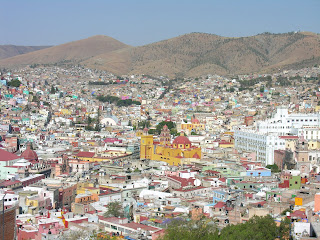That night at Appleby’s has been our last contact with Americana.
Guanjuato is very much a Mexican city, and very different from Morelia. Rather than the grid of streets and plazas in Renaissance Morelia, historic Guanajuato is a maze of narrow streets and even narrower alleys, giving it the feel of a medieval city. Built along the banks of a small river that flowed between steep hills, the streets and buildings followed the river and climb up and down the hillsides. (The river was put underground long ago, and amazingly, in the 1950’s, it was lowered once again, when an extensive subterranean roadway system was built. These tunnels allow traffic to move through the city, leaving parts of the historic center free of cars.)
Scattered throughout the maze of surface streets in the historic center are numerous churches, plazas, and small parks. The plazas and parks are irregularly shaped, just like in the medieval parts of European cities.
The social heart of the city, oddly enough, is not the plaza in front of the Basilica of our Lady of Guanajuato.
Scattered throughout the maze of surface streets in the historic center are numerous churches, plazas, and small parks. The plazas and parks are irregularly shaped, just like in the medieval parts of European cities.
The social heart of the city, oddly enough, is not the plaza in front of the Basilica of our Lady of Guanajuato.
Instead, the nearby Jardin de la Union serves this function.
Inside the triangular space of the plaza, a triangle of huge sculpted ficus trees creates both a shady walkway along the sides of the plaza, and a small “room” inside the trees. From a bandshell in this smaller room, an ensemble from the University of Guanajuato plays concerts two nights each week.
During the day, the walkways under the trees are lined with the tables of small vendors selling everything from tacky handicrafts to Christianity Jehovah Witness style.
At night, the vendors are replaced by roving bands of musicians that will serenade you, for a donation, of course. Each band has an elaborate costume to distinguish it from its competitors.
We choose a somewhat less accomplished madrigal for our evening’s entertainment.
At the wide end of the Jardin de la Union sit two quite wonderful buildings. The first is the Templo de San Diego. The façade of this church is an excellent example of the very ornate Churrigueresque style and dates from about 1784. It is adjacent to the east sides the Teatro Juarez. Sitting atop its front portico of Doric columns are colossal sculptures. Rising up to the portico are two flights of steps that serve as meeting places for both local students and older people studying Spanish at a nearby language school.
All of this, I know, makes Guanajuato sound like a wonderful place. And it does have much to recommend it, including a UNESCO World Heritage Site designation. However, none of this conveys the decay that permeates Guanajuato. The city was established following the 1558 discovery of silver, and for about 200 years, produced as much as one-third of the world’s silver. However, the wealth appears to have given out long ago, and most of the historic city has not been maintained in the interval.
Despite the decline, Guanajuarto is a lively town with a large university, three performing arts centers downtown, and many museums. Barbara and I have already attended a wonderful symphony concert featuring Suliman Tekalli, an incredible young violinist from Daytona Beach who teaches at UCF. (See http://www.youtube.com/watch?v=sPlo7K3kq6g&feature=related for an example of his playing.)
We look forward to exploring more of the city’s cultural venues and meeting its people.
Despite the decline, Guanajuarto is a lively town with a large university, three performing arts centers downtown, and many museums. Barbara and I have already attended a wonderful symphony concert featuring Suliman Tekalli, an incredible young violinist from Daytona Beach who teaches at UCF. (See http://www.youtube.com/watch?v=sPlo7K3kq6g&feature=related for an example of his playing.)
We look forward to exploring more of the city’s cultural venues and meeting its people.









Wow! I almost felt that I was there with you.
ReplyDeleteThank you for your excellent writing.
Marcus & Debra